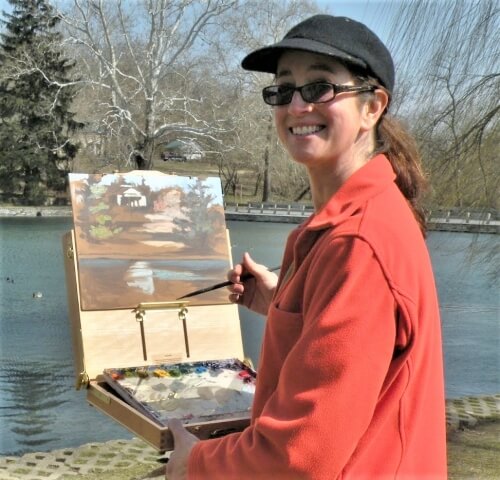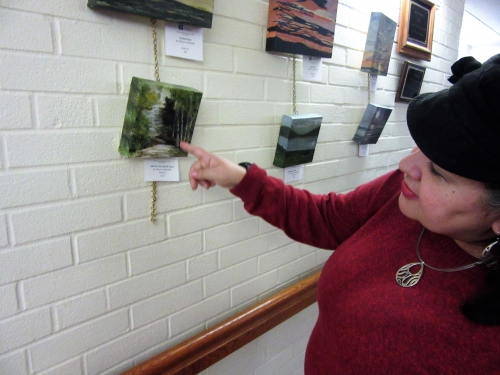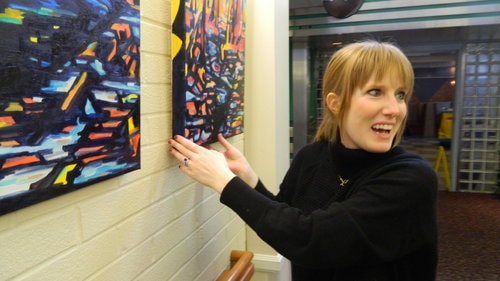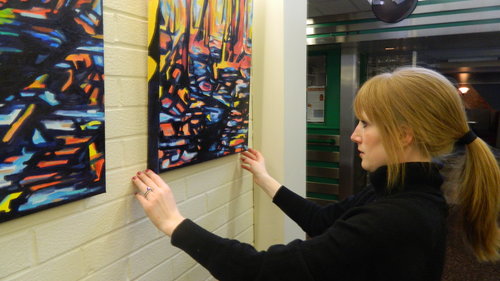Artist David McBride brings the sea and mountains to Homeland art gallery

Dave McBride – teacher, artist, traveler, family guy.
David McBride’s journey as an artist has brought him from scenic peninsulas to Homeland Center, where he is the artist on exhibit in the Florida Room gallery through September.
He loves the opportunity to bring beautiful scenes for Homeland residents, staff, and visitors to experience.
“I’m so happy to be here,” Dave says. “I want the pictures to be evocative. If you look at a beach scene, I want you to hear the waves.”
Year-round, Homeland’s Florida Room gallery is home to the works of artists made available through the Art Association of Harrisburg. The association works with organizations throughout the region to exhibit the work of member artists in offices and lobbies. Homeland is proud to be the only retirement community in the program.
By profession, Dave is a teacher. For 19 years, he taught special education in the East Pennsboro School District and now teaches physics and science.
The Harrisburg-born and raised McBride first picked up a paintbrush when his father, Wayne, took an art class with the Art Center School and Galleries in Mechanicsburg, PA.
“He left his paint box lying around,” Dave says. “Literally, I used dad’s paintbox. I still have some of his paints.”
Painting became a serious pursuit when Dave’s son and daughter – now 26 and 25 – got older. His “best critic and best supporter” was his mother, Lottie. She would make suggestions, requesting that he paint a bird or flowers.
“We’d sit at the table and paint with Q-tips,” he says. “We had fun. We laughed a lot. The paintings were horrible, and it didn’t matter.”
Dave first took classes at the Art Center School and Galleries with noted, and meticulous, landscape artist Ralph Hocker. Then he studied with the more impressionistic Jonathan Frazier, at Art Association of Harrisburg.
“Ralph said that if you want to learn how to paint a cow, paint 100 cows,” Dave says. He takes that approach to seascapes and mountains, including the series hanging at Homeland of the highest peaks on each continent that are known, collectively, as the Seven Summits.
Two vivid sunrise scenes in the exhibit – “Dawn’s Early Light” and “Corolla Dawn” – were painted at Bethany Beach, a favorite vacation spot. Dave doesn’t sleep in while on vacation, so he got outside with canvas and paints to capture the sun rising over the ocean. Because the scene changes so quickly, he captured what he could in broad outlines of blues and oranges and filled in the rest later.
Custom-selected frames from Smith Custom Framing & Fine Art Gallery in New Cumberland showcase each work’s unique qualities (www.smithcustomframing.com). Dave has shown in group shows, including at the Art Association of Harrisburg. Solo shows are daunting, but he learned to embrace the challenge after Hocker told him it was time to display his work.
“The shows are nerve-wracking,’’ Dave says. “You open yourself up. Every painting that you paint reflects yourself.”
One work shown at Homeland resulted from another challenge accepted. A fellow AAH artist suggested that Dave complete a larger canvas. He picked up a 16-by-20 canvas and depicted a gull, complete with shadows cast under the water splashing onto the shore, and cleverly titled it “Gullable.”
Dave posts his work on his blog, Dave’s Eclectic Art, at davemcbrideacrylics.wordpress.com. His wife, Sandy, liked a turtle that he painted and suggested that he do another. He produced a similar work of a swimming dolphin, lit by streams of sunlight breaking through the water, and framed by colorful sea vegetation. As soon as he posted it on the blog, a viewer asked about buying it.
He and Sandy are active at the church where they married, Camp Hill Presbyterian Church. Every year, she takes a mission trip to a disadvantaged region of Maine, where “for 30 miles around, there’s nothing.”
Just after Dave hung the Homeland show, they took a trip to the Olympic Peninsula, in Washington State. Dave took photos, even as he noted in memory the tonal shades of the majestic scenery and “the muted greens of the mist.”
“There’s a canvas on my easel waiting for me,” he says. “We’ll see what comes out.”







 In the 1920 and ‘30s, a Bavarian nun named Sister Maria Innocentia Hummel drew sketches capturing the innocence and charm of the children around her. As her sketches grew popular, German porcelain maker Franz Goebel began producing them in figurines – each piece subject to Sister Maria’s approval.
In the 1920 and ‘30s, a Bavarian nun named Sister Maria Innocentia Hummel drew sketches capturing the innocence and charm of the children around her. As her sketches grew popular, German porcelain maker Franz Goebel began producing them in figurines – each piece subject to Sister Maria’s approval.
